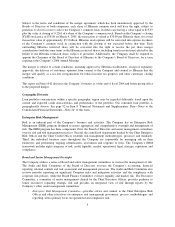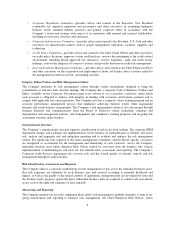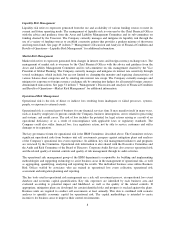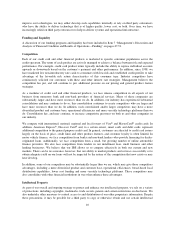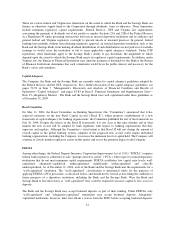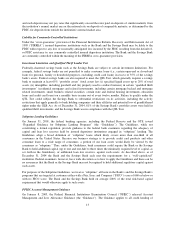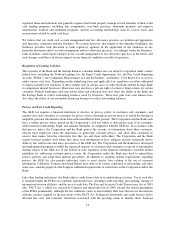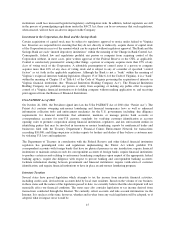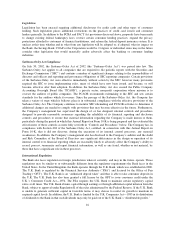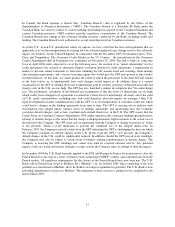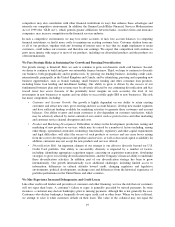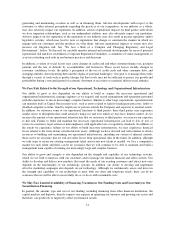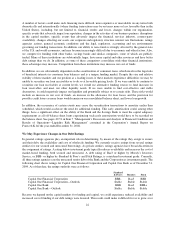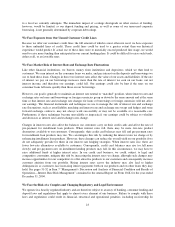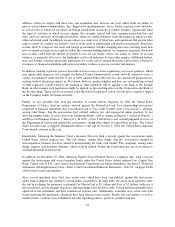Capital One 2004 Annual Report Download - page 37
Download and view the complete annual report
Please find page 37 of the 2004 Capital One annual report below. You can navigate through the pages in the report by either clicking on the pages listed below, or by using the keyword search tool below to find specific information within the annual report.regulated financial institutions and generally requires that banks properly manage several elements of their credit
card lending programs, including line assignments, over-limit practices, minimum payment and negative
amortization, workout and settlement programs, and the accounting methodology used for various assets and
income items related to credit card loans.
We believe that our credit card account management and loss allowance practices are prudent and appropriate
and, therefore, consistent with the Guidance. We caution, however, that similar to the subprime Guidelines, the
Guidance provides wide discretion to bank regulatory agencies in the application of the Guidance to any
particular institution and its account management and loss allowance practices. Accordingly, under the Guidance,
bank examiners could require changes in our account management or loss allowance practices in the future, and
such changes could have an adverse impact on our financial condition or results of operation.
Regulation of Lending Activities
The activities of the Bank and the Savings Bank as consumer lenders also are subject to regulation under various
federal laws, including the Truth-in-Lending Act, the Equal Credit Opportunity Act, the Fair Credit Reporting
Act (the “FCRA”), the Community Reinvestment Act and the Soldiers’ and Sailors’ Civil Relief Act, as well as
under various state laws. Depending on the underlying issue and applicable law, regulators are often authorized
to impose penalties for violations of these statutes and, in certain cases, to order the Bank and the Savings Bank
to compensate injured borrowers. Borrowers may also have a private right of action to bring actions for certain
violations. Federal bankruptcy and state debtor relief and collection laws also affect the ability of the Bank and
the Savings Bank to collect outstanding balances owed by borrowers. These laws plus state sales finance laws
also affect the ability of our automobile financing business to collect outstanding balances.
Privacy and Fair Credit Reporting
The GLB Act requires a financial institution to disclose its privacy policy to customers and consumers, and
requires that such customers or consumers be given a choice (through an opt-out notice) to forbid the sharing of
nonpublic personal information about them with nonaffiliated third persons. The Corporation and the Bank each
have a written privacy notice posted on the Corporation’s web site which is delivered to each of its customers
when customer relationships begin, and annually thereafter, in compliance with the GLB Act. In accordance with
that privacy notice, the Corporation and the Bank protect the security of information about their customers,
educate their employees about the importance of protecting customer privacy, and allow their customers to
remove their names from the solicitation lists they use and share with others. The Corporation and the Bank
require business partners with whom they share such information to have adequate security safeguards and to
abide by the redisclosure and reuse provisions of the GLB Act. The Corporation and the Bank have developed
and implemented programs to fulfill the expressed requests of customers and consumers to opt out of information
sharing subject to the GLB Act. If the federal or state regulators of the financial subsidiaries establish further
guidelines for addressing customer privacy issues, the Corporation and/or the Bank may need to amend their
privacy policies and adapt their internal procedures. In addition to adopting federal requirements regarding
privacy, the GLB Act also permits individual states to enact stricter laws relating to the use of customer
information. California, Vermont and North Dakota have done so by statute, regulation or referendum, and other
states may consider proposals which impose additional requirements or restrictions on the Corporation and/or the
Bank.
Like other lending institutions, the Bank utilizes credit bureau data in its underwriting activities. Use of such data
is regulated under the FCRA on a uniform, nationwide basis, including credit reporting, prescreening, sharing of
information between affiliates, and the use of credit data. The Fair and Accurate Credit Transactions Act of 2003
(the “FACT Act”), which was enacted by Congress and signed into law in 2004, extends the federal preemption
of the FCRA permanently, although the law authorizes states to enact identity theft laws that are not inconsistent
with the conduct required by the provisions of the FACT Act. If financial institutions and credit bureaus fail to
alleviate the costs and consumer frustration associated with the growing crime of identity theft, financial
14



